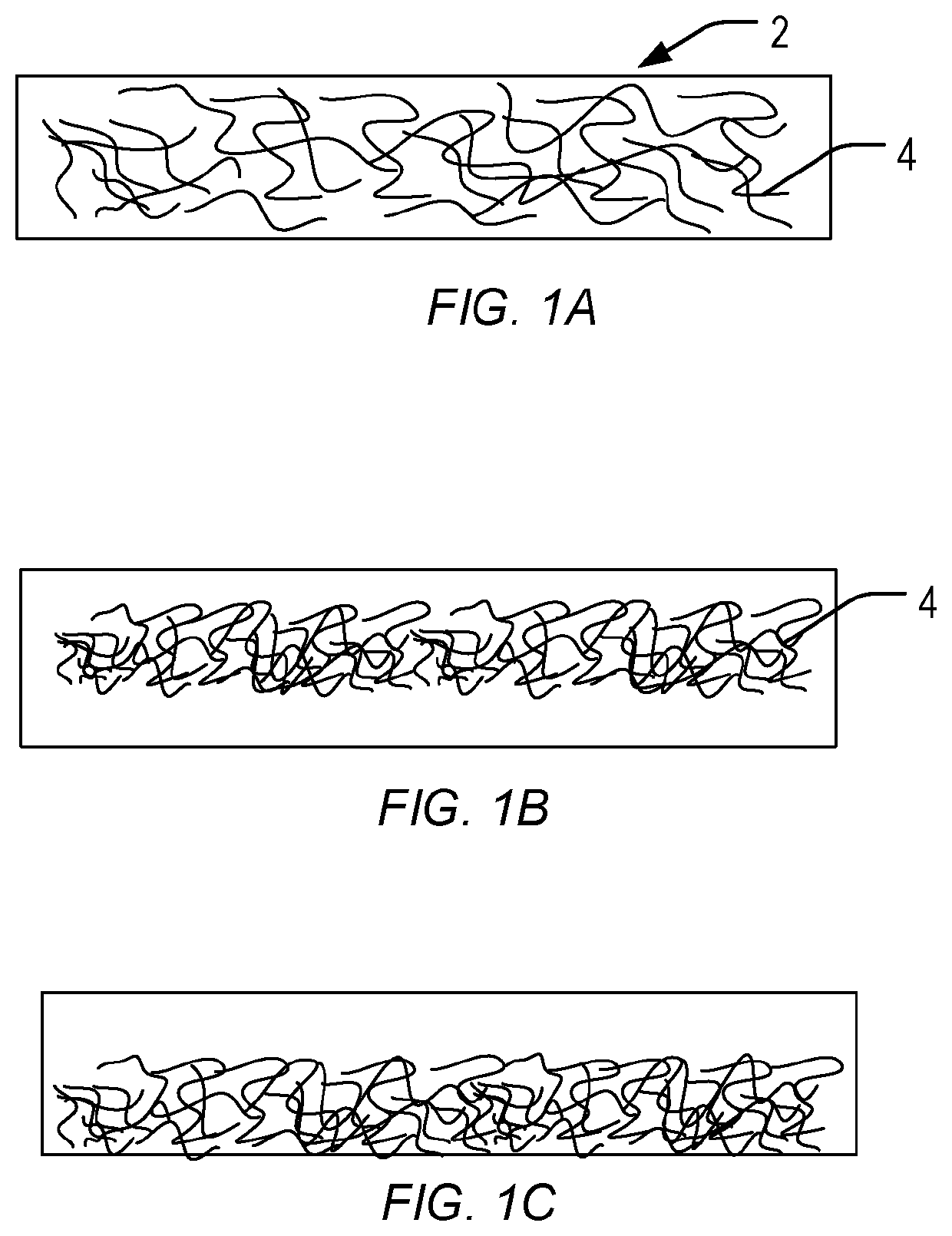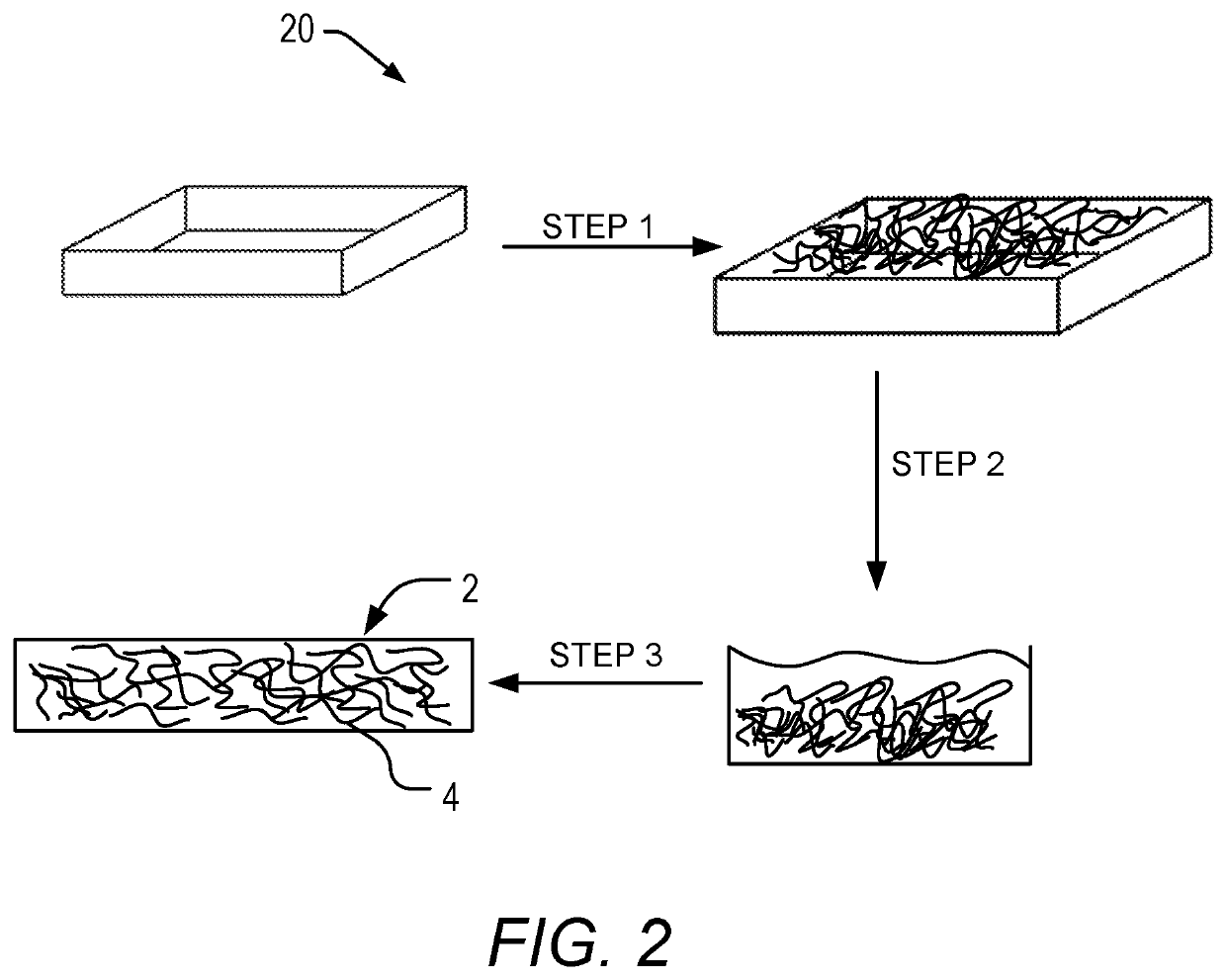Fiber-reinforced organic polymer aerogel
a fiber-reinforced organic polymer and aerogel technology, applied in the field of aerogels, can solve the problems of high cost, time-consuming, complicated processes, drying or super-drying, etc., and achieve the effects of superior mechanical properties, reduced thermal conductivity of fiber-reinforced aerogels, and cost- and time-efficient processes
- Summary
- Abstract
- Description
- Claims
- Application Information
AI Technical Summary
Benefits of technology
Problems solved by technology
Method used
Image
Examples
example 1
Single Layer Polyester Fiber-Reinforced Resorcinol Formaldehyde Aerogels
[0079]Fiber-reinforced resorcinol formaldehyde aerogels were produced in which the molar ratio of resorcinol to catalyst (R / C) in the gel precursor was 100, 200, 300, 400, or 500. The catalyst was calcium carbonate. The total solids content in the gel precursors (i.e., resorcinol, formaldehyde, and carbonate) was kept constant at 30% w / v. The molar ratio of resorcinol to formaldehyde (R / F) was fixed at 0.5.
[0080]For a chosen R / C ratio, the required resorcinol was placed in a sealable reactor with 50 mL of deionized water and mechanically stirred until completely dissolved. The calcium carbonate was added to the resorcinol solution with continued stirring until completely dissolved. The required volume of 37 wt. % formaldehyde solution and additional deionized water to give the total volume of 600 mL at 30% solids was added to the reactor, which was sealed and stirred for 30 min. This gel precursor solution was t...
example 2
Multi-Layer Polyester Fiber-Reinforced Resorcinol Formaldehyde Aerogels
[0083]Fiber-reinforced resorcinol formaldehyde aerogels were produced in which the molar ratio of resorcinol to catalyst ratio (R / C) in the gel precursor was 300, 400, or 500. The catalyst was calcium carbonate. The total solids content in the gel precursors (i.e., resorcinol, formaldehyde, and carbonate) was 20-30% w / v. The molar ratio of resorcinol to formaldehyde (R / F) was fixed at 0.5.
[0084]For a chosen R / C ratio, the required resorcinol was placed in a sealable reactor with 50 mL of deionized water and mechanically stirred until completely dissolved. The calcium carbonate was added to the resorcinol solution with continued stirring until completely dissolved. The required volume of 37 wt. % formaldehyde solution and additional deionized water to give the total volume of 600 mL at 20-30% solids depending on the formulation, was added to the reactor, which was sealed and stirred for 30 min. This gel precursor ...
example 3
Polyester Fiber-Reinforced Resorcinol Formaldehyde Aerogel Blankets of the Present Invention
[0086]Fiber-reinforced resorcinol formaldehyde aerogels were produced in which the molar ratio of resorcinol to catalyst (R / C) in the gel precursor was 400. The catalyst was calcium carbonate. The total solids content in the gel precursors (i.e., resorcinol, formaldehyde, and carbonate) was 30% w / v. The molar ratio of resorcinol to formaldehyde (R / F) was fixed at 0.5.
[0087]The required resorcinol was placed in a sealable reactor with 50 mL of deionized water and mechanically stirred until completely dissolved. The calcium carbonate was added to the resorcinol solution with continued stirring until completely dissolved. The required volume of 37 wt. % formaldehyde solution and additional deionized water to give the total volume of 600 mL at 30% solids was added to the reactor, which was sealed and stirred for 30 min. This gel precursor solution was then poured over a 1 cm thick polyester fiber...
PUM
| Property | Measurement | Unit |
|---|---|---|
| pore size | aaaaa | aaaaa |
| pore size | aaaaa | aaaaa |
| temperature | aaaaa | aaaaa |
Abstract
Description
Claims
Application Information
 Login to View More
Login to View More - R&D
- Intellectual Property
- Life Sciences
- Materials
- Tech Scout
- Unparalleled Data Quality
- Higher Quality Content
- 60% Fewer Hallucinations
Browse by: Latest US Patents, China's latest patents, Technical Efficacy Thesaurus, Application Domain, Technology Topic, Popular Technical Reports.
© 2025 PatSnap. All rights reserved.Legal|Privacy policy|Modern Slavery Act Transparency Statement|Sitemap|About US| Contact US: help@patsnap.com



